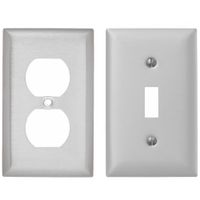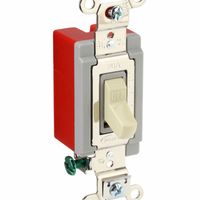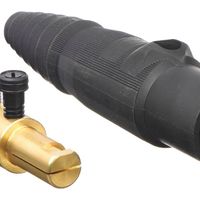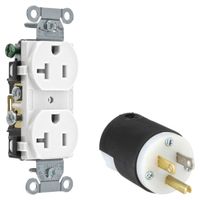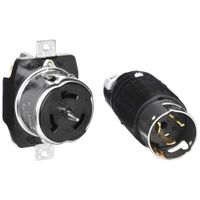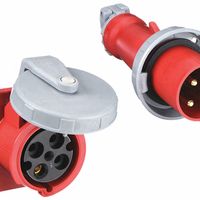Call +(254) 703 030 000 / 751 483 999 / 721 704 777
- Home
- Electrical
- Electrical Connectors Wiring Devices
- Plugs Receptacles Wiring Devices
.....Read More
Frequently Asked Questions
What is the difference between straight-blade and locking-blade plugs and receptacles?
Straight-blade plugs and receptacles are designed for general-purpose use, typically found in residential and light commercial applications. They feature flat, straight prongs and are easy to connect and disconnect. These plugs are suitable for devices that do not require a secure connection, as they rely on friction to stay in place. They are commonly used for household appliances, lamps, and other low-power devices.
Locking-blade plugs and receptacles, on the other hand, are designed for more demanding applications where a secure connection is critical. These plugs have curved or angled prongs that lock into place when inserted into the receptacle, preventing accidental disconnection. This feature is particularly important in industrial, commercial, and outdoor settings where vibrations, movement, or environmental factors could cause a straight-blade connection to come loose. Locking plugs are often used for heavy machinery, power tools, and equipment that require a stable power supply.
In summary, the main difference lies in the connection mechanism: straight-blade plugs rely on friction, while locking-blade plugs use a locking mechanism for a more secure connection.
How do NEMA ratings affect the selection of plugs and receptacles?
NEMA ratings significantly influence the selection of plugs and receptacles by providing standardized guidelines that ensure safety, compatibility, and suitability for specific environmental conditions. These ratings, established by the National Electrical Manufacturers Association, classify electrical enclosures based on their ability to withstand various environmental factors such as dust, water, corrosion, and other hazards.
When selecting plugs and receptacles, the NEMA rating helps determine the appropriate level of protection required for the application. For instance, a NEMA 1 rating indicates a basic level of protection suitable for indoor use, shielding against light dust and accidental contact. In contrast, a NEMA 4 or 4X rating is necessary for outdoor or industrial environments, offering protection against water, rain, and corrosion, with 4X providing additional resistance to corrosive agents.
The choice of NEMA-rated plugs and receptacles ensures compatibility with the environmental conditions they will be exposed to, preventing electrical failures and enhancing safety. For example, in a washdown area in a food processing plant, NEMA 4X-rated receptacles would be essential to withstand frequent cleaning and exposure to chemicals.
Furthermore, NEMA ratings help in ensuring compliance with local electrical codes and standards, which often mandate specific ratings for certain applications. This compliance is crucial for legal and insurance purposes, as well as for maintaining operational safety standards.
In summary, NEMA ratings guide the selection of plugs and receptacles by defining the necessary protection level against environmental factors, ensuring compatibility, safety, and compliance with regulatory standards, thereby preventing equipment failure and enhancing operational reliability.
What are pin and sleeve devices used for?
Pin and sleeve devices are used for providing secure and reliable electrical connections in industrial and commercial environments. They are designed to ensure safe power distribution in applications where equipment is exposed to harsh conditions, such as moisture, dust, chemicals, and extreme temperatures. These devices are commonly used in settings like manufacturing plants, construction sites, data centers, and outdoor events.
Pin and sleeve connectors consist of a male plug and a female receptacle, with pins and sleeves that align to create a secure connection. They are available in various configurations to accommodate different voltage and current requirements, typically ranging from 20 to 100 amps and 120 to 600 volts. The design of these connectors ensures that they are polarized, meaning they can only be connected in the correct orientation, which minimizes the risk of electrical faults.
One of the key features of pin and sleeve devices is their durability. They are often made from robust materials such as high-impact thermoplastics or metal, providing resistance to physical damage and environmental factors. Many models are also equipped with watertight seals and corrosion-resistant components, making them suitable for use in wet or corrosive environments.
Safety is a primary consideration in the design of pin and sleeve devices. They often include features such as locking mechanisms to prevent accidental disconnection, and color-coded housings to indicate voltage ratings and prevent mismatching. Additionally, they are designed to meet international standards, such as IEC 60309, ensuring compatibility and safety across different regions and applications.
Overall, pin and sleeve devices are essential for ensuring safe, reliable, and efficient power distribution in demanding environments, where traditional electrical connectors may not provide adequate protection or performance.
How do mechanical interlocks enhance safety in electrical connections?
Mechanical interlocks enhance safety in electrical connections by ensuring that certain conditions are met before an electrical circuit can be completed or interrupted. They physically prevent the operation of electrical devices unless specific safety criteria are satisfied, thereby reducing the risk of electrical hazards such as short circuits, electrical shocks, or equipment damage.
1. **Prevention of Incorrect Operation**: Mechanical interlocks ensure that devices like circuit breakers, disconnect switches, or contactors cannot be operated unless they are in the correct position. For example, a switch cannot be turned on if the enclosure door is open, preventing accidental contact with live parts.
2. **Sequential Operation**: They enforce a specific sequence of operations. For instance, in a motor control center, a mechanical interlock might ensure that a main breaker cannot be closed unless the feeder breakers are open, preventing overloads and ensuring safe startup procedures.
3. **Isolation Assurance**: Mechanical interlocks ensure that maintenance personnel can safely work on equipment. They prevent the re-energization of equipment while maintenance is being performed by ensuring that the power source cannot be reconnected until all safety conditions are met.
4. **Dual Redundancy**: By requiring both electrical and mechanical conditions to be satisfied, interlocks provide an additional layer of safety. Even if an electrical control system fails, the mechanical interlock can prevent unsafe operation.
5. **Human Error Reduction**: They minimize the potential for human error by physically preventing incorrect operations. This is particularly important in complex systems where multiple steps are required to safely operate equipment.
Overall, mechanical interlocks are a critical component in ensuring the safe operation of electrical systems, protecting both personnel and equipment from potential hazards.
What are the applications of high-current single-pole plugs and receptacles?
High-current single-pole plugs and receptacles are essential components in various industrial and commercial applications where robust and reliable electrical connections are required. These devices are designed to handle high amperage and are commonly used in the following areas:
1. **Entertainment and Events**: They are widely used in the entertainment industry for temporary power distribution at concerts, festivals, and theatrical productions. Their ability to handle high currents makes them ideal for powering stage lighting, sound systems, and other equipment.
2. **Construction Sites**: On construction sites, these plugs and receptacles provide temporary power for heavy machinery and tools. Their rugged design ensures durability and safety in harsh environments.
3. **Mining Operations**: In mining, high-current single-pole connectors are used to supply power to large equipment and machinery. Their robust construction is suitable for the demanding conditions found in mining operations.
4. **Shipyards and Marine Applications**: These connectors are used in shipyards for powering welding equipment and other heavy-duty tools. Their corrosion-resistant materials make them suitable for marine environments.
5. **Industrial Manufacturing**: In manufacturing plants, they are used to connect high-power equipment such as motors, generators, and transformers. Their ability to handle high currents ensures efficient and reliable power distribution.
6. **Emergency and Backup Power Systems**: They are crucial in emergency power systems, including backup generators and temporary power setups during outages. Their quick-connect design allows for rapid deployment and connection.
7. **Renewable Energy**: In renewable energy installations, such as wind and solar farms, these connectors are used to connect power generation equipment to the grid or storage systems, ensuring efficient energy transfer.
Overall, high-current single-pole plugs and receptacles are vital for applications requiring secure, high-capacity electrical connections, ensuring safety, reliability, and efficiency across various industries.
How do I determine the correct NEMA configuration for my application?
To determine the correct NEMA configuration for your application, follow these steps:
1. **Identify Voltage and Current Requirements**: Determine the voltage (e.g., 120V, 240V, 480V) and current (amperage) requirements of your equipment. This information is crucial as NEMA configurations are designed to handle specific voltage and current levels.
2. **Determine Phase and Frequency**: Identify whether your application requires single-phase or three-phase power and the frequency (e.g., 60Hz in the U.S., 50Hz in many other countries).
3. **Understand Plug and Receptacle Types**: Familiarize yourself with the NEMA plug and receptacle types. NEMA configurations are coded with a combination of letters and numbers (e.g., NEMA 5-15, NEMA L6-30). The first number indicates the configuration type, the letter 'L' indicates a locking type, and the second number indicates the amperage rating.
4. **Consider Environmental Conditions**: Determine if your application is in a dry, wet, or hazardous location. NEMA enclosures have different ratings (e.g., NEMA 1 for general indoor use, NEMA 4 for outdoor use, NEMA 7 for hazardous locations) that protect against environmental factors.
5. **Check Compatibility**: Ensure that the NEMA configuration you choose is compatible with existing equipment and infrastructure. This includes checking the compatibility of plugs, receptacles, and connectors.
6. **Consult Standards and Regulations**: Refer to local electrical codes and standards, such as the National Electrical Code (NEC) in the U.S., to ensure compliance with safety and installation requirements.
7. **Seek Professional Advice**: If unsure, consult with an electrical engineer or a professional electrician to ensure the correct NEMA configuration is selected for your specific application.
By following these steps, you can accurately determine the appropriate NEMA configuration for your application, ensuring safety, compatibility, and compliance.
What are the benefits of using sealed connectors in outdoor and industrial environments?
Sealed connectors offer numerous benefits in outdoor and industrial environments, primarily due to their ability to protect electrical connections from harsh conditions. These connectors are designed to prevent the ingress of moisture, dust, dirt, and other contaminants, which can cause corrosion, short circuits, and electrical failures. This protection ensures reliable performance and longevity of the electrical systems.
In outdoor settings, sealed connectors are crucial for withstanding environmental elements such as rain, snow, and extreme temperatures. They maintain the integrity of the connection, reducing the risk of downtime and maintenance costs associated with weather-related damage. In industrial environments, where machinery and equipment are often exposed to dust, chemicals, and vibrations, sealed connectors provide robust protection, ensuring consistent operation and safety.
Sealed connectors also enhance safety by preventing accidental disconnections and reducing the risk of electrical shocks. Their design often includes locking mechanisms that secure the connection, which is vital in high-vibration environments like automotive or heavy machinery applications.
Furthermore, sealed connectors contribute to the overall efficiency of systems by minimizing energy loss and ensuring optimal electrical conductivity. This efficiency is critical in applications where power reliability is paramount, such as telecommunications, transportation, and renewable energy sectors.
In summary, the benefits of using sealed connectors in outdoor and industrial environments include protection against environmental and industrial contaminants, enhanced safety, reduced maintenance costs, improved reliability and efficiency, and extended lifespan of electrical systems. These advantages make sealed connectors an essential component in ensuring the durability and performance of electrical connections in challenging conditions.
